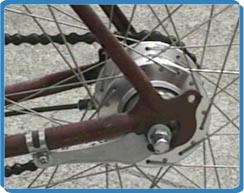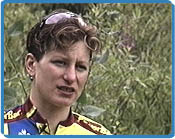|

|
|
Braking & Steering
Page: 1 of 3
|

Brakes have improved as materials and engineering know-how
have evolved. The earliest bicycles lacked brakes, which added to their
daredevil reputation. For bikes to become more popular an effective mechanism
for slowing and stopping had to be devised. All brakes, regardless of the
mechanism, share one thing in common--they increase the amount of friction
(usually on the wheel) allowing the rider to slow or stop. Steering a bicycle
has remained a constant. While handlebars have evolved, the fundamentals
of steering and controlling a bicycle haven't changed. But recently our
understanding of the science behind steering a bicycle has.
|

|
Women's Downhiller Missy Giove depends on quick reflexes and cutting edge
technology. Downhill racing is perhaps the most dangerous of all cycling
sports. More on Missy on Page 2 of this section.
|
|
IMAGE COURTESY OF CANNONDALE BICYCLES
|
|
|
Take the Plunge
The first widely used braking system was know as the plunger.
It first appeared on the high-wheelers of the 1800s. The principle of the
plunger brake is simple: by pressing down or pulling up on lever, a metal
shoe is pressed against the outside of a tire creating friction and slowing
the bicycle down. The problems with this system include excess wear on the
tire (it doesn't work well with pneumatic tires, even when the metal shoe
is covered with rubber) and poor performance on wet surfaces. Water decreases
the friction between the brake shoe and the tire, lessening the braking
power.
|
|
Coaster Brake
The coaster brake is still in wide use throughout the world
and appears in a number of less sophisticated bicycles like cruisers and
utility bicycles. Coaster brakes also appear on some children's bicycles
and tricycles. The coaster brake works by reversing the motion on the pedals.
The brake mechanism is inside the hub of the wheel and pushes outward on
the hub, creating friction and slowing the bike. This brake is particularly
strong and tends to "lock up" or skid the rear wheel when engaged.
|

|
A coaster brake on an old "cruiser" bicycle.
|
|
|
Caliper Brakes
The most popular brake for road and mountain bicycles is
the caliper rim brake. The cyclist engages these brakes by pulling on levers
which pull cables, forcing pads or shoes against the inner rim of the front
or rear wheel. Caliper brakes are lightweight and inexpensive but they are
not without problems. During wet weather it may take twice the distance
to stop as it does in dry. The water acts a lubricant on the sides of the
rims. During very long downhills the rims can heat up, even to the point
of melting a hole in the tire's inner tube!
|
|
When using caliper brakes, riders are advised to place gentle
pressure on the brakes and modulate in a controlled fashion. Controlled
modulation will help brakes perform better, particularly in wet weather,
by removing some of the excess liquid from the rims. In addition, pumping
the brakes will ensure the rider does not lock-up the brakes (when the tires
stop spinning, the cyclist begins to lose control over the bicycle). Exploratorium
Senior Scientist, Paul Doherty explained, "I balance the braking between
the skidding the wheel on the ground and the skidding of the brake blocks.
If I go into a skid so the wheels aren't spinning, I don't have control when
I point the wheels of the bicycle. Just like the anti-lock brakes on a car,
I want to keep that wheel rolling a little bit so I can steer and control
the bicycle."
|


|
Paul Doherty talks about braking.
|
|
|
Balancing the braking between the front and rear tire is also
important. Paul explained, "The most important things about stopping
are that you want to stop quickly, in control, and not go over the handlebars.
As I'm going along on the bicycle and I apply the brakes, my body has inertia
and it still tends to go forward. That shifts my weight forward onto the
front wheel. So, I do a lot of braking with the front wheel, but if I do
too much braking with the front wheel, then I wind up going over the handlebars.
So the idea of the braking the bicycle is to balance the braking between
the front and the back to get the maximum braking."
|
|
U.S. Women's cross-country champion, Ruthie Matthes sees
planning as a key to effective braking for many of the reasons that Paul
cited. Ruthie told us, "We have the fortune in our racing to be able
to pre-ride the courses so we can plan our braking." Ruthie continued
to explain her technique for braking on sharp turns. "What I do when
I'm racing, if I'm coming into a sharp corner I'll brake ahead of the corner,
and as I'm going into the corner release the front brake and only use the
rear brake."
|


|
Ruthie Matthes talks about her techniques for braking.
|
|
|
|
Braking & Steering
Page: 1 of 3
Select "Forward" below to continue
|

©
Exploratorium
|

